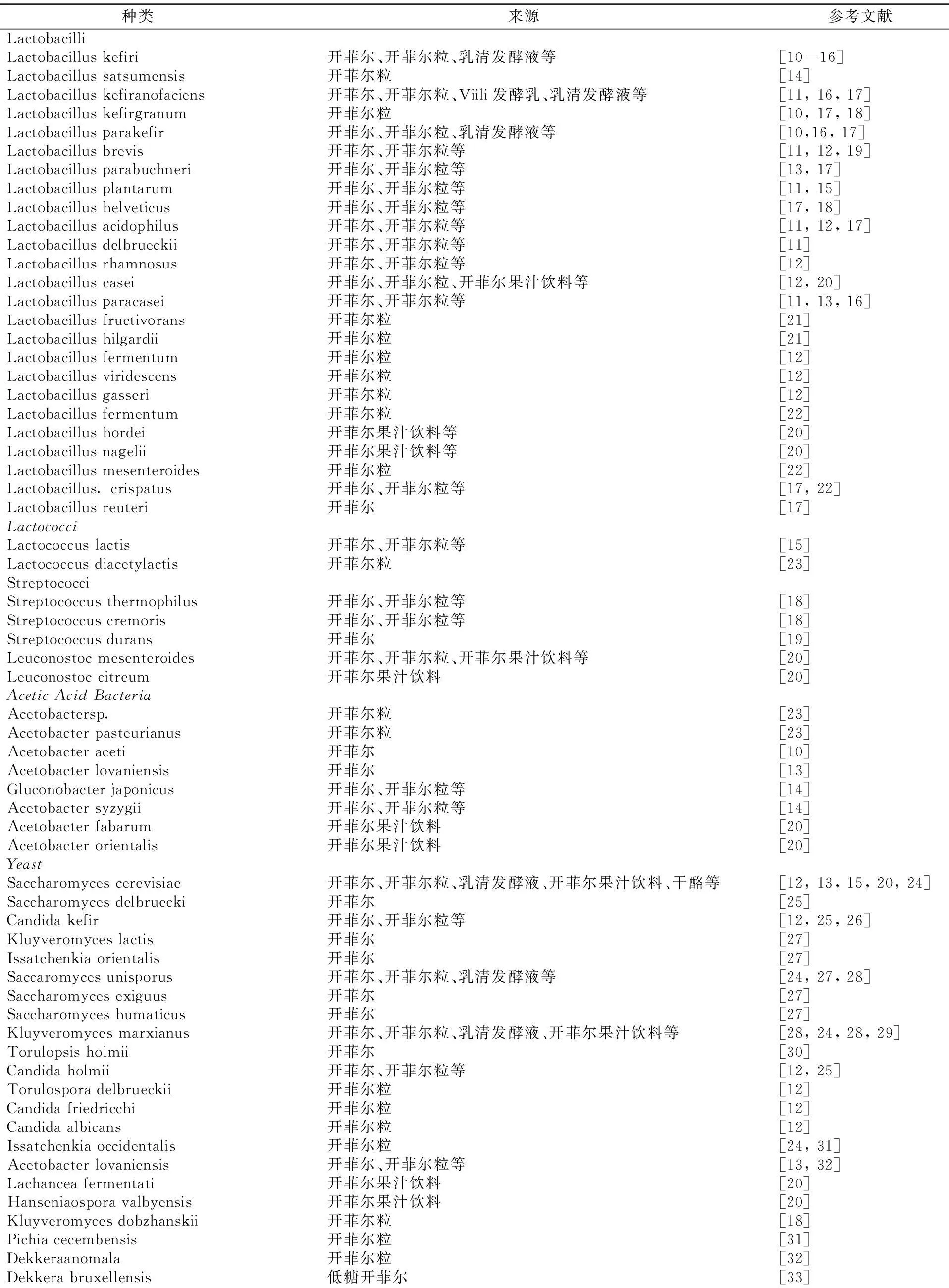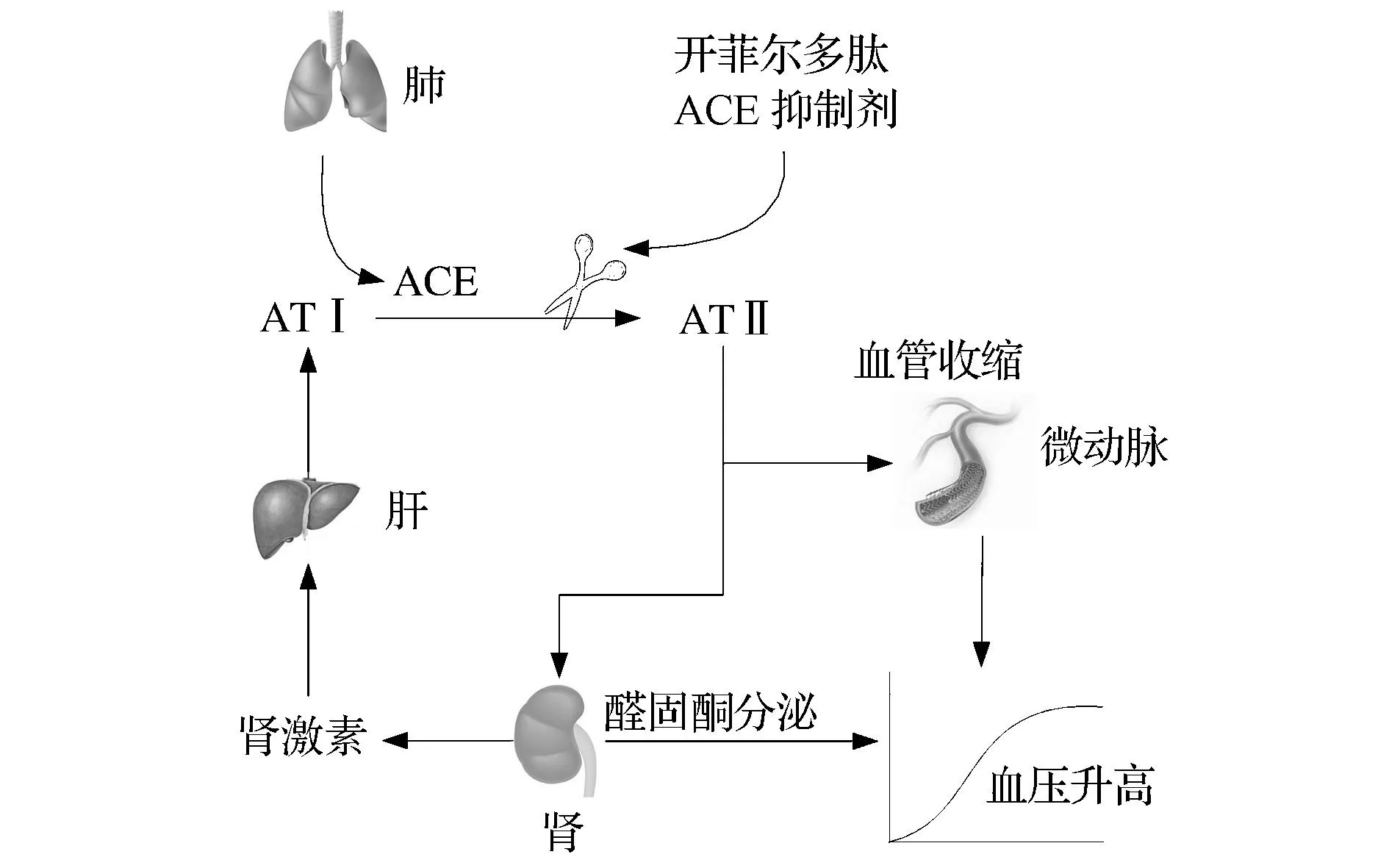开菲尔产品微生态、成分和功能活性的研究进展
高鑫,梅俊,李博*
1(上海工会管理职业学院 健康安全系,上海,201415) 2(上海交通大学 食品科学与工程系,上海,200240)
开菲尔产品微生态、成分和功能活性的研究进展
高鑫1,梅俊2,李博1*
1(上海工会管理职业学院 健康安全系,上海,201415)2(上海交通大学 食品科学与工程系,上海,200240)
摘要开菲尔粒是传统酸奶开菲尔的发酵剂,其微生物组成较为复杂,该文对国内外研究开菲尔及其发酵产品的文献进行总结,介绍了开菲尔粒及其发酵产品的微生物多样性、成分和功能活性。开菲尔粒是一种混菌发酵体系,其蛋白质、多糖构成的骨架上栖息着乳酸菌、酵母菌和醋酸菌等多种有益微生物。在发酵牛乳时,能同时进行乳酸、醋酸和酒精发酵,其产物在抗癌、降压、抑菌、提高免疫力和缓解乳糖不耐症等功能活性方面发挥了重要作用。
关键词开菲尔;微生物多样性;成分;功能活性
开菲尔粒,也称克菲尔粒,最早起源于高加索地区,主要在前苏联、欧洲、中东等地区流行。开菲尔粒能够发酵牛奶、羊奶等而制得一种含醇、酸及少量CO2的发酵乳,称为开菲尔(Kefir)。Kefir来源于土耳其语“Keyif”,有安宁、幸福之意[1]。开菲尔粒在我国主要分布在新疆天山和青藏高原地区,称之为藏灵菇,或者是西藏雪莲。开菲尔粒是一种乳白色、胶质状的块状物,外形酷似米粒,表面卷曲,多为白色或浅黄色,大小一般在2~3 cm。将开菲尔粒放在牛奶中培养,个体会增大[2]。
开菲尔粒是一种混菌发酵体系,其蛋白质、多糖构成的骨架上栖息着乳酸菌、酵母菌和醋酸菌等多种有益微生物。在发酵牛乳时,能同时进行乳酸、醋酸和酒精发酵,从而使制品兼有酸味和醇味[3]。经开菲尔粒发酵的酸奶和市售酸奶有着较大差别,除了具有市售酸奶的酸味、香味外,还有由乳酸、CO2、乙醛、乙偶姻、微量的醇和其他发酵风味产品相互混合得到的特殊风味[4]。与此同时,开菲尔粒在发酵的过程中会产生水溶性多糖,因此,所得到的酸奶比市售酸奶具有更高的黏性[5-6]。袁祎琳等对藏灵菇发酵纯牛奶过程中的物性变化进行了分析,并和市售酸奶进行了比较。藏灵菇酸奶的黏度曲线基本都呈开口向上的不对称抛物线状,且抛物线的最低点接近600 s(转子的剪切速率接近0 s-1)处,同时其微观结构较市售酸奶致密平整[7]。本文对开菲尔粒及其发酵产品开菲尔的微生物多样性、成分及其功能活性进行了概括论述。
1微生物多样性
目前,在对开菲尔粒及其发酵产品的诸多研究中,最关注的就是对不同地区的开菲尔粒微生物多样性进行研究。开菲尔粒及发酵产品的微生物群落主要是细菌和酵母,它们之间呈现共生关系,共生关系的存在为分离鉴定开菲尔粒及其发酵产品中的微生物组成造成了一些困难。ABRAHAM等认为,开菲尔粒在发酵过程中会有较高的微生物数量,其质量不低于开菲尔总重的0.9%。开菲尔中细菌的菌落总数在6.4×104~8.5×108CFU/g之间,而酵母菌落总数在1.5×105~3.7×108CFU/g之间[8]。IRIGOYEN等人将开菲尔粒发酵24 h后的微生物进行初步分离,得到乳杆菌(108CFU/mL)、乳酸乳球菌(105CFU/mL)、酵母(106CFU/mL)和乙酸菌(106CFU/mL)等[9]。开菲尔粒及其发酵产品的微生物主要是乳酸菌、乙酸菌和酵母菌类,对于部分文献中的开菲尔粒及其发酵产品中微生物的分离鉴定进行了总结,如表1所示。
2成分分析
LOPITZ-OTSOA等报道,开菲尔粒约含有90%水分、3.2%蛋白质、0.3%脂类、5.8%非氮类可溶性物和0.7%灰分[34]。从宏观看,开菲尔粒中微生物聚集在一种胶状物质上,用手触摸, 具有黏性和弹性。多项研究表明,这些胶状物质主要是多糖和蛋白质。
表1 开菲尔粒及其发酵产品中分离到的微生物总结
Table 1 The summary of microora species isolated from kefir grains and their fermented products

表1 开菲尔粒及其发酵产品中分离到的微生物总结
种类来源参考文献LactobacilliLactobacilluskefiri开菲尔、开菲尔粒、乳清发酵液等[10-16]Lactobacillussatsumensis开菲尔粒[14]Lactobacilluskefiranofaciens开菲尔、开菲尔粒、Viili发酵乳、乳清发酵液等[11,16,17]Lactobacilluskefirgranum开菲尔粒[10,17,18]Lactobacillusparakefir开菲尔、开菲尔粒、乳清发酵液等[10,16,17]Lactobacillusbrevis开菲尔、开菲尔粒等[11,12,19]Lactobacillusparabuchneri开菲尔、开菲尔粒等[13,17]Lactobacillusplantarum开菲尔、开菲尔粒等[11,15]Lactobacillushelveticus开菲尔、开菲尔粒等[17,18]Lactobacillusacidophilus开菲尔、开菲尔粒等[11,12,17]Lactobacillusdelbrueckii开菲尔、开菲尔粒等[11]Lactobacillusrhamnosus开菲尔、开菲尔粒等[12]Lactobacilluscasei开菲尔、开菲尔粒、开菲尔果汁饮料等[12,20]Lactobacillusparacasei开菲尔、开菲尔粒等[11,13,16]Lactobacillusfructivorans开菲尔粒[21]Lactobacillushilgardii开菲尔粒[21]Lactobacillusfermentum开菲尔粒[12]Lactobacillusviridescens开菲尔粒[12]Lactobacillusgasseri开菲尔粒[12]Lactobacillusfermentum开菲尔粒[22]Lactobacillushordei开菲尔果汁饮料等[20]Lactobacillusnagelii开菲尔果汁饮料等[20]Lactobacillusmesenteroides开菲尔粒[22]Lactobacillus.crispatus开菲尔、开菲尔粒等[17,22]Lactobacillusreuteri开菲尔[17]LactococciLactococcuslactis开菲尔、开菲尔粒等[15]Lactococcusdiacetylactis开菲尔粒[23]StreptococciStreptococcusthermophilus开菲尔、开菲尔粒等[18]Streptococcuscremoris开菲尔、开菲尔粒等[18]Streptococcusdurans开菲尔[19]Leuconostocmesenteroides开菲尔、开菲尔粒、开菲尔果汁饮料等[20]Leuconostoccitreum开菲尔果汁饮料[20]AceticAcidBacteriaAcetobactersp.开菲尔粒[23]Acetobacterpasteurianus开菲尔粒[23]Acetobacteraceti开菲尔[10]Acetobacterlovaniensis开菲尔[13]Gluconobacterjaponicus开菲尔、开菲尔粒等[14]Acetobactersyzygii开菲尔、开菲尔粒等[14]Acetobacterfabarum开菲尔果汁饮料[20]Acetobacterorientalis开菲尔果汁饮料[20]YeastSaccharomycescerevisiae开菲尔、开菲尔粒、乳清发酵液、开菲尔果汁饮料、干酪等[12,13,15,20,24]Saccharomycesdelbruecki开菲尔[25]Candidakefir开菲尔、开菲尔粒等[12,25,26]Kluyveromyceslactis开菲尔[27]Issatchenkiaorientalis开菲尔[27]Saccaromycesunisporus开菲尔、开菲尔粒、乳清发酵液等[24,27,28]Saccharomycesexiguus开菲尔[27]Saccharomyceshumaticus开菲尔[27]Kluyveromycesmarxianus开菲尔、开菲尔粒、乳清发酵液、开菲尔果汁饮料等[28,24,28,29]Torulopsisholmii开菲尔[30]Candidaholmii开菲尔、开菲尔粒等[12,25]Torulosporadelbrueckii开菲尔粒[12]Candidafriedricchi开菲尔粒[12]Candidaalbicans开菲尔粒[12]Issatchenkiaoccidentalis开菲尔粒[24,31]Acetobacterlovaniensis开菲尔、开菲尔粒等[13,32]Lachanceafermentati开菲尔果汁饮料[20]Hanseniaosporavalbyensis开菲尔果汁饮料[20]Kluyveromycesdobzhanskii开菲尔粒[18]Pichiacecembensis开菲尔粒[31]Dekkeraanomala开菲尔粒[32]Dekkerabruxellensis低糖开菲尔[33]

表1 开菲尔粒及其发酵产品中分离到的微生物总结
Pichiacaribbica开菲尔粒[31]Zygosaccharomycesfermentati开菲尔粒[31]
1967年, RIVIERE等首次对开菲尔粒的结构进行了系统研究,发现在开菲尔粒上的微生物栖息在由自己产生多糖基质上,并将这种多糖命名为Kefiran。开菲尔粒中约有50%的成分是多糖,由1∶1的半乳糖和葡萄糖组成,可作为开菲尔粒的支撑体或微生物栖息场所。WANG等从西藏开菲尔粒中分离到Lb.plantarumKF5,能够产胞外多糖,该多糖是杂多糖,其组成比例为甘露糖、葡萄糖和半乳糖近似比为1∶4.99∶6.90。利用原子力显微镜对不同浓度下的胞外多糖进行微观观察,在低浓度时,该胞外多糖的水溶液沉积物呈现链状和球状。利用扫描电镜进行观察,发现其具有相互覆盖的紧密结构。因此可以判断,构成藏灵菇的微生物所分泌产生的胞外多糖在形成和维持藏灵菇颗粒结构中起着重要作用。同时,WANG等在分离到的Lb.kefiranofaciensZW3菌株产生的胞外多糖进行了研究,FT-IR光谱显示该多糖是一类由羧基、氨基和酰胺基组成典型的杂聚多糖[35]。
RIMADA等利用开菲尔粒CIDCA AGK1对牛奶和脱蛋白乳清进行发酵,并利用不同方法对多糖的提取率进行了对比研究。当利用加热作为提取第一步时,所得到的多糖提取率增加,利用两步乙醇沉淀法得到的多糖浓度最高[36]。对于开菲尔粒中分离得到的Kefiran多糖利用研究主要集中在可食膜方面,目前,Kefiran多糖在浓度5~10g/kg的时候能够形成可食膜。Kefiran多糖膜溶液在低浓度时符合流体力学性质,而在高浓度时则表现出假塑性,增塑剂甘油的添加并不会改变膜液的流变性能。但是在膜液中不添加甘油所得到的膜具有较高的弹性模量、高拉伸强度值、低断裂拉伸力,比较脆硬[37]。在Kefiran多糖的医学应用上,MAEDA等利用小鼠为模型进行了研究,发现Kefiran多糖能够显著抑制血压升高和降低胆固醇水平,同时Kefiran多糖也能够明显改变小鼠的便秘情况[38]。
对开菲尔粒中蛋白质的研究主要集中在开菲尔粒中的S-layer(Surface proteins)蛋白上,它是覆盖在细菌表层形成一层膜结构,在体外自发组装成重复的晶体结构,在某些开菲尔乳杆菌发挥益生菌活性、自动聚集凝集和抑制病原菌生长等功能上有着重要作用[39]。
而对于开菲尔粒发酵酸奶开菲尔来讲,不同地区的原奶经过发酵后得到的开菲尔成分不同。研究人员发现开菲尔在成分上的差异主要是由于原料奶的成分差异,开菲尔粒微生物多样性不同,以及制作开菲尔的习惯和工艺不同。在开菲尔中,市售酸奶的所有重要营养成分都能够找得到。其中,水分含量最多,其次是乳糖、蛋白、脂肪和灰分,还含有少量的乙醇、乳酸和CO2[40]。CO2的含量取决于开菲尔粒的添加量,开菲尔粒越多,CO2的含量也就越高。一般来讲,在开菲尔中理想的CO2浓度应该不超过1.98 g/L[41]。发酵过程中产物,如乳酸、乙酸、丙酮酸、马尿酸、丙酸、丁酸、双乙酰、乙醛等,会增加开菲尔的风味和香气。双乙酰和乙醛是开菲尔中的主要风味成分[4]。与市售普通酸奶相比,开菲尔含有1/2乳酸,2倍丙酮酸,9倍乙酸。同时,存放条件也会影响开菲尔的成分,在4 ℃下存放会降低乙醇、乙醛和乙偶姻的浓度,但双乙酰的浓度不会下降[42]。此外,开菲尔中也存在相当数量的维生素和微量元素。乙酸菌在开菲尔制作过程中会合成维生素B2和尼克酸,酵母菌在发酵过程中会合成维生素B1、维生素B2和维生素B12,丙酸菌的代谢能提高B族维生素的含量,其中维生素B12和叶酸的含量比普通酸奶高4~5倍[43]。实际上,开菲尔的高营养价值要归结于含量平衡的营养物质。
3开菲尔粒及其发酵产品的功能活性
开菲尔粒及其发酵产品自身的多样微生物和丰富的营养成分使其具有很高的功能活性,如抑菌性、改善肠道健康、抗癌、降低血糖和胆固醇、增强免疫力等。开菲尔粒及其发酵产品中的成分与功能活性之间的关系简要总结如表2。
3.1抗癌活性
开菲尔粒及其发酵产品在抗癌性活性方面的研究已经开展很长时间,抗癌活性与开菲尔粒及其发酵产品中的蛋白质和多糖有关。蛋白质和多糖可以将致癌物前体在转化为致癌物过程中产生作用,使致癌物前体转化为失活物质(图1)。蛋白质也可以抑制致癌物对基因的损坏和由基因损坏导致肿瘤细胞的萌生。开菲尔含有中等量的四碳双羧酸,可在有机体内溶解癌细胞。同时,开菲尔也可以增强人体的免疫系统,通过对体液免疫和细胞免疫的调节作用,能够增强巨噬细胞能力和自然杀伤细胞的活力,清除异常突变细胞,也可以起到防癌和抗癌的功效[60]。
3.2降压活性
开菲尔粒及其发酵产品在降血压方面的作用主要是能够抑制血管紧张素转换酶(ACE)的活性,ACE可以将血管紧张素(AT)I转化成AT II,AT II是一种强效血管收缩剂,可以刺激肾脏中的醛固酮分泌,能使肾脏保留更多的液体在体内,从而升高血压(图2)。开菲尔中的某些肽可以作为ACE的抑制剂,阻止AT I转化成AT II,从而调节血压[60]。

表2 开菲尔粒及其发酵产品中的功能活性[44]
3.3抑菌活性
研究人员发现开菲尔中的乳杆菌会产生一些抑菌性化合物,如有机酸、过氧化氢、乙醛、CO2和细菌素等,在一定程度上能够抑制病原微生物的生长繁殖[11]。一般情况下,开菲尔对革兰氏阳性菌的抑菌效果要比阴性菌要好。MARQUINA等经过动物实验对比发现,在小鼠模型中使用开菲尔会使得肠道中的乳酸菌数量增加,而肠杆菌和梭状芽胞杆菌的数目减少[49]。
3.4提高免疫活性
食物的营养和免疫活性之间有着直接关系,开菲尔中的乳酸菌及其发酵产物能明显提高特异性或非特异性免疫应答。通过食用开菲尔,肺及腹腔中的巨噬细胞能够降低致病菌的活性,从而影响身体各部位的黏膜应答。开菲尔中发微生物也改变了外来微生物细胞因子的响应,提高了先天免疫能力。VINDEROLA等发现开菲尔可以诱导黏膜应答提高免疫力,从而维持肠道内环境稳定[61]。IRAPORDA等在研究开菲尔奶酒时将提高免疫活性的原因归结于代谢过程中产生的乳酸盐,在一定浓度下能够抑制由白介素-1β、肿瘤坏死因子-α和鞭毛蛋白引起肠道上皮细胞的激活[62]。

图1 体内肿瘤形成和开菲尔的作用部位[60]Fig.1 Tumor formation in body and proposed sites of action of kefir

图2 开菲尔调节血压的作用示意图[60]Fig.2 Role of kefir in regulating blood pressure
3.5缓解乳糖不耐症
乳糖不耐症的发生是由于肠道中没有足够的β-半乳糖苷酶或者是活性不足,β-半乳糖苷酶可以讲解乳糖生成葡萄糖和半乳糖。如果β-半乳糖苷酶活性不足,乳糖到肠道内后会被大肠中的细菌消化产生CO2,从而引起胃肠道不适。发酵乳制品是目前唯一能够缓解乳糖不耐症的解决方法,开菲尔粒中的一些微生物如Lb.delbrueckiisubsp.bulgaricus和S.salivariussubsp.thermophilus可以产生β-半乳糖苷酶发酵乳糖[63]。
4结论
目前,对开菲尔的研究取得了一定的进展,但是还有许多问题亟待解决。开菲尔粒中微生物多样性较为复杂,微生物之间的共生关系和比例组成并不是一成不变,随气候和培养基等变化,对于大规模商业化生成来讲难以得到合适的发酵剂。同时在发酵过后开菲尔粒的回收、清洗等工作存在着感染杂菌的风险。因此,研究如何获得合适的冻干粉发酵剂是今后研究的热点之一。同时,开菲尔产品的口味应当多样化,以满足不同人群的需要。
参考文献
[1]SABIR F,BEYATLI Y,COKMUS C,et al. Assessment of potential probiotic properties ofLactobacillusspp.,Lactococcusspp.,andPediococcusspp. strains isolated from kefir[J]. Journal of Food Science,2010,75(9):M568-M573.
[2]LIKOTRAFITI E,VALAVANI P,ARGIRIOU A,et al.Invitroevaluation of potential antimicrobial synbiotics usingLactobacilluskefiri isolated from kefir grains[J]. International Dairy Journal,2015,45:23-30.
[3]HAMET MF,PIERMARIA JA,ABRAHAM AG. Selection of EPS-producingLactobacillusstrains isolated from kefir grains and rheological characterization of the fermented milks[J]. LWT-Food Science and Technology,2015,63(1):129-135.
[4]周传云,唐书泽,聂明,等. 利用开菲尔粒制备酸豆乳酒的最佳发酵条件[J]. 食品与发酵工业,2004,30(3):33-35.
[6]SERAFINI F,TURRONI F,RUAS-MADIEDO P,et al. Kefir fermented milk and kefiran promote growth ofBifidobacteriumbifidum PRL2010 and modulate its gene expression[J]. International Journal of Food Microbiology,2014,178:50-59.
[7]袁祎琳,李云飞,梅俊,等. 藏灵菇发酵纯牛奶过程中的物性变化[J]. 食品工业科技,2013,34(10):208-211.
[8]WITTHUHN RC,SCHOEMAN T,BRITZ TJ. Isolation and characterization of the microbial population of different South African kefir grains[J]. International Journal of Dairy Technology,2004,57(1):33-37.
[9]IRIGOYEN A,ARANA I,CASTIELLA M,et al. Microbiological, physicochemical, and sensory characteristics of kefir during storage[J]. Food Chemistry,2005,90(4):613-620.
[10]TAKIZAWA S,KOJIMA S,TAMURA S,et al.Lactobacilluskefirgranumsp. nov. andLactobacillusparakefirsp. nov.,two new species from kefir grains[J]. International Journal of Systematic Bacteriology,1994,44(3):435-439.
[11]SANTOS A,SAN MAURO M,SANCHEZ A,et al. The antimicrobial properties of different strains ofLactobacillusspp. isolated from kefir[J]. Systematic and Applied Microbiology,2003,26(3):434-437.
[12]ANGULO L,LOPEZ E,LEMA C. Microflora present in kefir grains of the Galician region (North-West of Spain) [J]. Journal of Dairy Research,1993,60(2):263-267.
[13]MAGALHãES KT,PEREIRA GVM,DIAS DR,et al. Microbial communities and chemical changes during fermentation of sugary Brazilian kefir[J]. World Journal of Microbiology and Biotechnology,2010,26(7):1 241-1 250.
[14]MIGUEL MGCP,CARDOSO PG,DE ASSIS L L,et al. Diversity of bacteria present in milk kefir grains using culture-dependent and culture-independent methods[J]. Food Research International,2010,43(5):1 523-1 528.
[15]BOLLAPA,de LOS Angeles Serradell M,de URRAZA PJ,et al. Effect of freeze-drying on viability andinvitroprobiotic properties of a mixture of lactic acid bacteria and yeasts isolated from kefir[J]. Journal of Dairy Research,2011,78(1):15-22.
[16]HAMET MF,LONDERO A,MEDRANO M,et al. Application of culture-dependent and culture-independent methods for the identification ofLactobacilluskefiranofaciensin microbial consortia present in kefir grains[J]. Food Microbiology,2013,36(2):327-334.
[17]DOBSON A,O'SULLIVAN O,COTTER P D,et al. High-throughput sequence-based analysis of the bacterial composition of kefir and an associated kefir grain[J]. FEMS Microbiology Letters,2011,320(1):56-62.
[19]DENG Y,MAN C,FAN Y,et al. Preparation of elemental selenium-enriched fermented milk by newly isolatedLactobacillusbrevisfrom kefir grains[J]. International Dairy Journal,2015,44:31-36.
[20]GULITZ A,STADIE J,WENNING M,et al. The microbial diversity of water kefir[J]. International Journal of Food Microbiology,2011,151(3):284-288.
[21]YOSHIDA Y,YOKOI W,OHISHI K,et al. Effects of the cell wall ofKluyveromycesmarxianusYIT 8292 on the plasma cholesterol and fecal sterol excretion in rats fed on a high-cholesterol diet[J]. Bioscience,Biotechnology,and Biochemistry,2005,69(4):714-723.
[22]GARBERS I,BRITZ T,WITTHUHN R. PCR-based denaturing gradient gel electrophoretictypification and identification of the microbial consortium present in kefir grains[J]. World Journal of Microbiology and Biotechnology,2004, 20(7):687-693.
[23]GARROTE G L,ABRAHAM A G,De ANTONI G L. Chemical and microbiological characterisation of kefir grains[J]. Journal of Dairy Research,2001. 68(4):639-652.
[24]DIOSMA G,ROMANIN D E,REY-BURUSCO M F,et al. Yeasts from kefir grains:isolation,identification,and probiotic characterization[J]. World Journal of Microbiology and Biotechnology,2014,30(1):43-53.
[25]MARSHALL V M. Starter cultures for milk fermentation and their characteristics[J]. International Journal of Dairy Technology,1993,46(2):49-56.
[26]LATORRE-GARCA L,del CASTILLO-AGUDO L,POLAINA J. Taxonomical classification of yeasts isolated from kefir based on the sequence of their ribosomal RNA genes[J]. World Journal of Microbiology and Biotechnology,2007,23(6):785-791.
[27]MARSH A J,O'SULLIVAN O,HILL C,et al. Sequencing-based analysis of the bacterial and fungal composition of kefir grains and milks from multiple sources[J]. PloS One,2013,8(7):e69371.
[28]IWASAWA S,UEDA M,MIYATA N,et al. Identification and fermentation character of kefir yeast[J]. Agricultural and Biological Chemistry,1982,46(11):2 631-2 636.
[29]DIOSMA G,ROMANIN D E,REY-BURUSCO M F,et al. Yeasts from kefir grains:isolation,identification,and probiotic characterization[J]. World Journal of Microbiology and Biotechnology,2014,30(1):43-53.
[30]LEITE A M O,LEITE D C A,DEL AGUILA E M,et al. Microbiological and chemical characteristics of Brazilian kefir during fermentation and storage processes[J]. Journal of Dairy Science,2013,96(7):4 149-4 159.
[31]da CP MIGUEL M G,CARDOSO P G,MAGALHES K T,et al. Profile of microbial communities present in tibico (sugary kefir) grains from different Brazilian States[J]. World Journal of Microbiology and Biotechnology,2011,27(8):1 875-1 884.

[33]LAUREYS D,DE VUYST L. Water kefir as a promising low-sugar probiotic fermented beverage[J]. Archives of Public Health,2014,72(1):1.
[34]LOPITZ-OTSOA F,REMENTERIA A,ELGUEZABAL N,et al. Kefir:una comunidad simbiótica de bacterias y levaduras con propiedades saludables[J]. Revista Iberoamericana de Micología,2006,23(2):67-74.
[35]WANG Y,AHMED Z,FENG W,et al. Physicochemical properties of exopolysaccharide produced byLactobacilluskefiranofaciensZW3 isolated from Tibet kefir[J]. International Journal of Biological Macromolecules,2008,43(3):283-288.
[36]RIMADA P S,ABRAHAM A G. Comparative study of different methodologies to determine the exopolysaccharide produced by kefir grains in milk and whey[J]. Le Lait,2003,83(1):79-87.
[37]GHASEMLOU M,KHODAIYAN F,OROMIEHIE A,et al. Development and characterisation of a new biodegradable edible film made from kefiran,an exopolysaccharide obtained from kefir grains[J]. Food Chemistry,2011,127(4):1 496-1 502.
[38]MAEDA H,ZHU X,OMURA K,et al. Effects of an exopolysaccharide (kefiran) on lipids,blood pressure,blood glucose,and constipation[J]. Biofactors,2004,22(1):197-200.
[39]KESMEN Z,KACMAZ N. Determination of lactic microflora of kefir grains and kefir beverage by using culture-dependent and culture-independent methods[J]. Journal of Food Science,2011,76(5):M276-M283.
[40]WONG N P. Fundamentals of Dairy Chemistry[M]. Berlin:Springer Science & Business Media,2012.
[41]GARROTE G L,ABRAHAM A G,DE ANTONI G L. Inhibitory power of kefir:the role of organic acids[J]. Journal of Food Protection,2000,63(3):364-369.
[42]KLYAVINYA L. Department for dairy products for children[J]. Molochnaya Promyshlennost,1980,3:11-12.
[43]金世琳. 古老而新型的酒精性发酵乳饮料——开菲尔[J]. 中国乳品工业,1999,27(2):18-23.
[44]GUZEL-SEYDIM ZB,KOK-TAS T,GREENE AK,et al. Review:functional properties of kefir[J]. Critical Reviews in Food Science and Nutrition,2011,51(3):261-268.
[45]VINDEROLA C G,DUARTE J,THANGAVEL D,et al. Immunomodulating capacity of kefir[J]. Journal of Dairy Research,2005,72(2):195-202.
[46]HONG W S,CHEN H C,CHEN Y P,et al. Effects of kefir supernatant and lactic acid bacteria isolated from kefir grain on cytokine production by macrophage[J]. International Dairy Journal,2009,19(4):244-251.
[47]URDANETA E,BARRENETXE J,ARANGUREN P,et al. Intestinal beneficial effects of kefir-supplemented diet in rats[J]. Nutrition Research,2007,27(10):653-658.
[48]LIU J R,WANG S Y,CHEN M J,et al. The anti-allergenic properties of milk kefir and soymilk kefir and their beneficial effects on the intestinal microflora[J]. Journal of the Science of Food and Agriculture,2006,86(15):2 527-2 533.
[49]MARQUINA D,SANTOS A,CORPAS I,et al. Dietary influence of kefir on microbial activities in the mouse bowel[J]. Letters in Applied Microbiology,2002,35(2):136-140.
[50]De VRESE M,KELLER B,BARTH C A. Enhancement of intestinal hydrolysis of lactose by microbial b-galactosidase (EC 3.2. 1.23) of kefir[J]. British Journal of Nutrition,1992,67(1):67-75.
[51]GARROTE G L,DELFEDERICO L,BIBILONI R,et al. Lactobacilli isolated from kefir grains:evidence of the presence of S-layer proteins[J]. Journal of Dairy Research,2004,71(2):222-230.
[52]LIU J R,CHEN M J,LIN C W. Antimutagenic and antioxidant properties of milk-kefir and soymilk-kefir[J]. Journal of Agricultural and Food Chemistry,2005,53(7):2 467-2 474.
[53]SVENSSON M,SABHARWAL H,HÅKANSSON A,et al. Molecular characterization of α-lactalbumin folding variants that induce apoptosis in tumor cells[J]. Journal of Biological Chemistry,1999,274(10):6 388-6 396.
[54]TOPUZ E,DERIN D,CAN G,et al. Effect of oral administration of kefir on serum proinflammatory cytokines on 5-FU induced oral mucositis in patients with colorectal cancer[J]. Investigational New Drugs,2008,26(6):567-572.
[55]NAGIRA T,NARISAWA J,KUSUMOTO K,et al. Protection of human melanoma cells from UV damage by a fermented milk,Kefir[J]. Animal Cell Technology,1999,10:369-374.
[56]LIU J R,WANG S Y,LIN Y Y,et al. Antitumor activity of milk kefir and soy milk kefir in tumor-bearing mice[J]. Nutrition and Cancer,2002,44(2):183-187.
[57]LIU J R,WANG S Y,CHEN M J,et al. Hypocholesterolaemic effects of milk-kefir and soyamilk-kefir in cholesterol-fed hamsters[J]. British Journal of Nutrition,2006,95(5):939-946.
[58]MOREIRA M E C,SANTOS M H D,ZOLINI G P P,et al. Anti-inflammatory and cicatrizing activities of a carbohydrate fraction isolated from sugary kefir[J]. Journal of Medicinal Food,2008,11(2):356-361.
[59]GUZEL-SEYDIM Z,SEYDIM A,GREENE A. Comparison of amino acid profiles of milk,yogurt and Turkish kefir[J]. Milchwissenschaft,2003,58(3-4):158-160.
[60]AHMED Z,WANG Y,AHMAD A,et al. Kefir and health:a contemporary perspective[J]. Critical Reviews in Food Science and Nutrition,2013,53(5):422-434.
[61]VINDEROLA G,PERDIGN G,DUARTE J,et al. Effects of the oral administration of the products derived from milk fermentation by kefir microflora on immune stimulation[J]. Journal of Dairy Research,2006,73(4):472-479.
[62]IRAPORDA C,ROMANIN D E,RUMBO M,et al. The role of lactate on the immunomodulatory properties of the nonbacterial fraction of kefir[J]. Food Research International,2014,62:247-253.
[63]LEITE A M O,MIGUEL M A L,PEIXOTO R S,et al. Probiotic potential of selected lactic acid bacteria strains isolated from Brazilian kefir grains[J]. Journal of Dairy Science,2015,98(6):3 622-3 632.
Research on microbial diversities, chemical composition and functional activities of kefir grains and their fermented products
GAO Xin1, MEI Jun2, LI Bo1*
1(Department of Health and security, Shanghai Vocational Management College of Trade Union, Shanghai 201415, China)2(Department of Food Science and Technology, Shanghai Jiao Tong University, Shanghai 200240, China)
ABSTRACTKefir grains is a starter in the traditional yoghourt “kefir” and the microbial components is very complicated. In the text, some literature about kefir grains and their fermented products were summarized and the microbial diversity, composition and functional activity were introduced. Kefir grains is a kind of mixed bacteria fermentation system, and lactic acid bacteria, yeast and acetic acid bacteria inhabit on its skeleton composed by protein and polysaccharide. When the milk is fermented with kefir grains, the lactic acid, alcohol and acetic acid fermentation can simultaneously be carried out. The products play an important role in anticancer activities, antihypertensive activities, antibacterial activities, enhancing immunity, and reducing lactose intolerance, which provide theoretical basis for use of kefir grains and their fermented products as functional foods.
Key wordskefir grain; microbial diversities; composition; functional activity
收稿日期:2015-08-03,改回日期:2015-09-10
基金项目:上海市高校选拔培训优秀青年教师科研专项基金资助项目(ghz09005)
DOI:10.13995/j.cnki.11-1802/ts.201603043
第一作者:硕士,讲师(李博为通讯作者,E-mail:hellob1101@163.com)。

